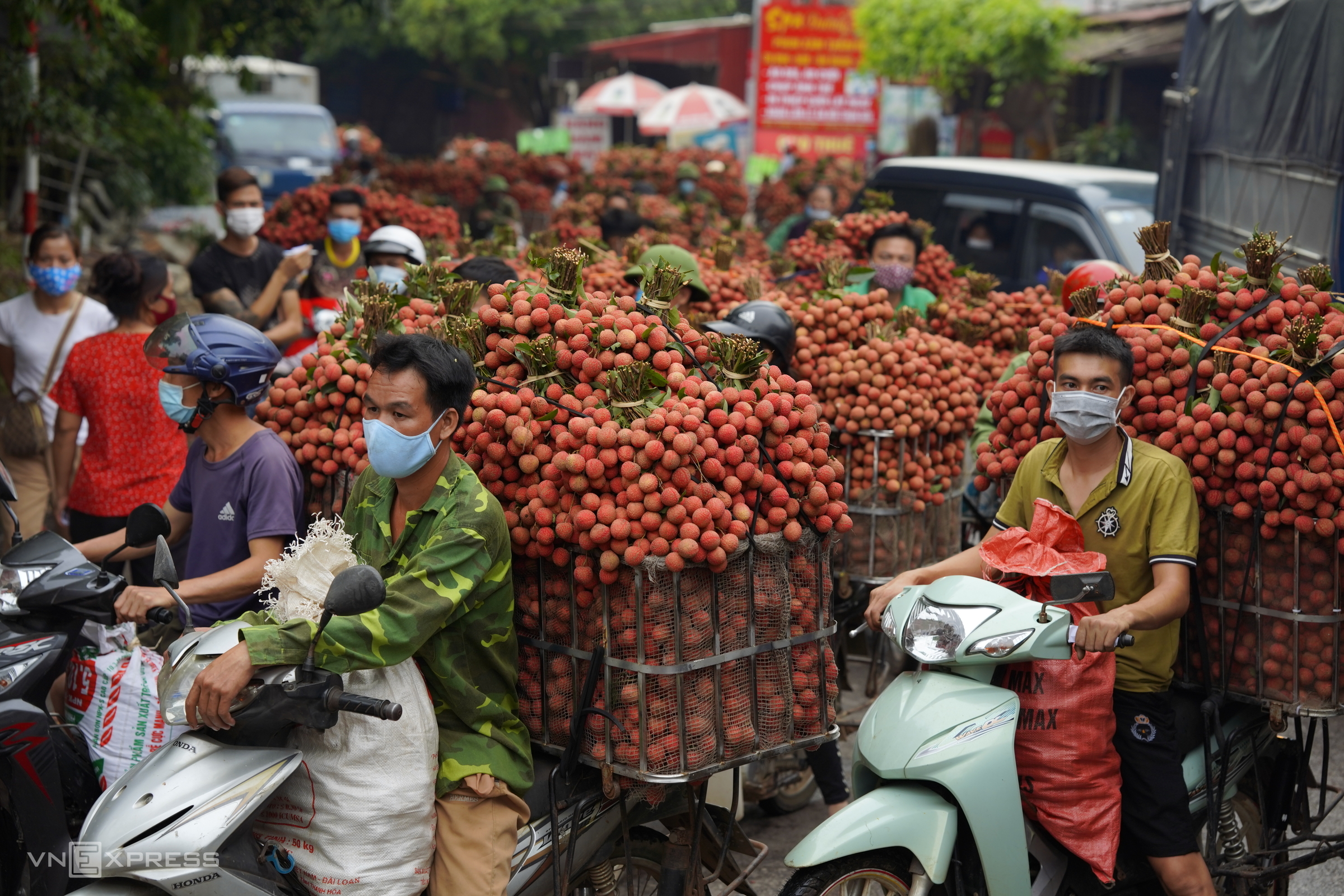Across the Mekong Delta and northern Vietnam, the main harvest season for durian, jackfruit, and lychees is underway. However, instead of celebrating, many farmers are struggling with low prices and slow sales.
Surveys of growing regions reveal durian prices have fallen to 30,000-70,000 VND per kg, while Thai jackfruit fetches only 5,000-10,000 VND per kg, sometimes even dropping below 4,000 VND. Watermelons face a similar situation, with prices at the farm gate ranging from 3,000-7,000 VND per kg. Regular lychees sell for 8,000-10,000 VND per kg at the orchard, a third of last year's price.
Mr. Luc, a long-time lychee farmer in Luc Ngan, said this year his family's orchard yielded a good harvest, with beautiful and uniform fruit. However, the selling price is only around 10,000 VND per kg, a third less than the same period last year. With nearly one hectare of lychees ready for harvest, Mr. Luc estimates his family will face losses if prices don't rise, as production costs range from 8,000 to 12,000 VND per kg.
Similarly, Mr. Hung, a durian farmer in Tien Giang, said his family recently sold 10 tons of Ri6 durian for 30,000 VND per kg, the lowest price ever for this variety. After deducting expenses such as fertilizer, labor, transportation, and packaging, his family's durian orchard only broke even this year.
 |
Lychee harvest season in Bac Giang. Photo: Ngoc Thanh |
Lychee harvest season in Bac Giang. Photo: Ngoc Thanh
According to the Vietnam Fruit and Vegetable Association (VINAFRUIT), several factors contribute to the sharp drop in fruit prices. First, China, the main export market, has tightened quality control measures, particularly for durian, focusing on the level of aurous cyanide, a compound with potential health risks. This has slowed exports, making businesses hesitant to sign new contracts.
Furthermore, extended customs clearance times and rising logistics costs hinder timely exports. Other markets like South Korea and Thailand have also reduced purchases due to domestic protection policies or large inventories. As a result, total fruit and vegetable export revenue in the first 5 months of the year reached only 2.3 billion USD, down 13.5% year-on-year, with exports to China declining by 35%.
Domestically, abundant supply puts further pressure on prices. This year's fruit season has seen a bumper crop. Durian production is estimated to exceed 1.5 million tons, while national lychee production is around 250,000 tons, a 25% increase over last year. The plentiful supply combined with weak purchasing power has caused fruit prices to plummet.
Not only fruit, but many vegetables like water spinach, winter melon, and malabar spinach are also selling for just a few thousand VND per kg at the farm. According to a recent report by the Ministry of Agriculture and Environment, oversupply is widespread, while purchasing power has not yet recovered. The report compiles production and consumption data for the first 5 months of this year from key provinces and cities like Tien Giang, Dong Thap, and Dak Lak. In Tien Giang, the price of grade 1 Ri6 durian decreased by 31%, Monthong durian by 15.6%, and tangerines by 10.4%, while only a few items like watermelon and Cat xoai mango saw slight increases.
In addition to fruits and vegetables, key agricultural exports like coffee and pepper have also experienced significant price drops recently, despite the main harvest season ending. In the Central Highlands, the price of Robusta coffee beans fell to 93,500 VND per kg, the lowest level since the beginning of the year, a 31% drop from its peak in March. Pepper prices also fell to 128,000 VND per kg, a 25% decline in less than three months.
"The amount of goods held by farmers is not much, but prices continue to plummet," said Nguyen Nam Hai, Chairman of the Vietnam Coffee-Cocoa Association (VICOFA). He explained that the price decline is not due to domestic supply but rather pressure from the global market, with a bumper crop in Brazil and large inventories in Indonesia. Meanwhile, the rising USD has led investors to take profits, putting Vietnamese coffee at a disadvantage.
Similarly, pepper is facing pressure from its traditional consumer markets. In the US and Europe, inflation and monetary tightening have led to a sharp decline in consumption. Businesses are reducing orders and prioritizing clearing existing inventories. China, the other major partner, continues to import but not enough to offset the weak global demand. Meanwhile, pepper stockpiled since the beginning of the year is being released all at once, causing prices to crash.
To address these challenges, at a meeting in June on solutions for durian exports, Minister of Agriculture and Environment Do Duc Duy called for a review of growing areas to avoid spontaneous expansion that could create supply-demand imbalances. He emphasized the need for better planning, developing closed-loop value chains, upgrading cold storage and logistics centers, and disseminating sustainable farming practices. Grower code numbers need to be protected and strictly monitored to maintain the reputation of Vietnamese goods in the international market.
Along with central government directives, businesses and localities are urgently implementing trade promotion solutions to boost agricultural product consumption. Many specialties are being offered by airlines to passengers. Growing regions are also connecting with supermarket systems and wholesale markets to quickly distribute surplus fruit. Some localities like Long An and Ben Tre are promoting domestic trade, putting agricultural products on e-commerce platforms, and connecting with canteens and schools.
On the business side, many large exporters are actively expanding markets to bring Vietnamese agricultural products to more countries. Notably, fruit and vegetable exports to the European Union (EU) have grown strongly recently. According to customs data, in the first 4 months of 2025, fruit and vegetable export revenue to the EU reached 132 million USD, up 33% year-on-year.
Thi Ha












